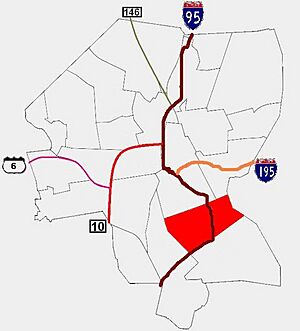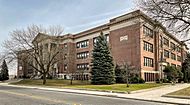Lower South Providence, Providence, Rhode Island facts for kids
The Lower South Side (also known as Lower South Providence) is a neighborhood in the southern part of Providence, Rhode Island. It has clear borders: Public Street to the north (next to Upper South Providence), Interstate 95 to the south (next to Washington Park), Broad Street to the west (next to Elmwood), and the Providence River to the east.
Contents
History of Lower South Providence
The area we now call Lower South Providence was once mostly open fields where animals grazed.
Early Days and Growth
In 1754, this land became part of the new town of Cranston. It did not become part of Providence again until 1868. A big change happened in 1865 when a streetcar line was built. It ran along Public Street and then down Ocean Street. This streetcar made the Lower South Side Providence's first "streetcar suburb." This meant people could live there and easily travel to work or other places using the streetcar. In the next ten years, new streets and buildings quickly appeared wherever the streetcar went.
Immigrants and Industry
Between 1860 and 1880, many Irish immigrants started moving to the southern part of Lower Providence. During this time, the population of Providence nearly doubled to about 105,000 people. In 1868, Cranston gave the Lower South Side (and Washington Park) back to Providence.
The Upper South Side was good for factories because it was close to downtown. But the Lower South Side had better access to Narragansett Bay and shipping routes through the Port of Providence. Because of this, factories that made metal and jewelry started to open there. By the 1870s, most homes in the area were duplexes, which are buildings with two separate living spaces. Working-class families often rented these homes.
By 1900, new electric train lines made transportation even faster. There was also plenty of affordable housing. This helped the Lower South Side to grow and do well. Between 1900 and 1950, many families who had lived there for a while became more successful. They often moved to newer, richer areas.
Changes with Cars
After 1950, cars became very popular, and this changed the area a lot. The building of Interstate 95, a major highway, meant that many buildings had to be torn down. This highway also cut off the neighborhood from the waterfront, which used to be very important.
Green spaces like yards were turned into driveways and garages. Street improvements also meant that many tree-lined streets lost their trees. People started looking for newer, more prosperous neighborhoods farther away.








